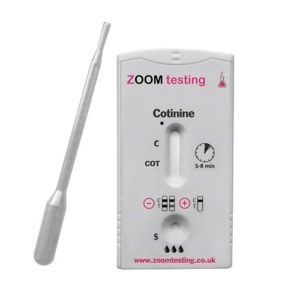When it comes to drug screening, tobacco use is very often evaluated with a nicotine/cotinine test.
The Dangers Of Tobacco Products
Prolonged use of tobacco products can lead to increased risk of developing several diseases like Chronic obstructive pulmonary disease (COPD), heart disease, lung cancer, stroke and respiratory tract infections, or even worsen blood clotting and asthma. Pregnant women who smoke tobacco are exposed to the risk of foetal growth retardation which can lead to birth of babies with low weights.
Since the use of tobacco products can have great effect on individual’s health, a nicotine/cotinine test can be used by companies to detect tobacco use by prospective employees. There are also some life and health insurance companies which test applicants for nicotine or cotinine (nicotine metabolite).
Testing For Smoking
We can measure both nicotine and cotinine quantitatively and qualitatively. Qualitative testing is used to detect the presence or absence of nicotine/cotinine while quantitative testing is used to measure the concentration of nicotine/cotinine. Quantitative testing can help to distinguish between the following sets of people:
- Active smokers;
- Tobacco users who quit smoking recently;
- Non-tobacco smokers who have suffered from significant exposure to tobacco smoke in their environment;
- Non-tobacco users who have suffered no exposure at all.
We can also measure cotinine in the hair or saliva, although hair testing is used mainly for research purposes such as in the study of non-smokers’ exposure to the smoke of tobacco.
A doctor may perform nicotine/cotinine testing if somebody is suspected to have had an overdose of nicotine.
How Do I Interpret the Test Result?
The levels of nicotine in the blood can rise sharply in just a few seconds of puffing a cigarette. The quantity of the nicotine in the blood is dependent on that in the cigarette and how the person smokes, for instance, show deeply he or she inhales. The concentration of nicotine in urine is higher than that in the saliva or blood. The levels of nicotine in the blood also vary from one individual to another and also depend on some genetic variations relating to the rate of nicotine metabolism, and on the rate of removal of cotinine from the body. When you quit tobacco smoking and other related nicotine products, the cotinine levels in your blood can take over 2 weeks to drop to those of a non-tobacco user and a couple of weeks more for the cotinine concentrations in your urine to drop.
Generally, nicotine/cotinine high levels are an indication of active use of nicotine or tobacco replacement. Medium concentrations are an indication that a user of tobacco has not taken tobacco or nicotine for 2-3 weeks. Lower nicotine/cotinine levels may be detected in a person who does not use tobacco but suffers from environmental smoke exposure. Very low levels and untraceable concentrations are detected in non-users of tobacco who do not suffer from environmental smoke exposure or users who, for a couple of weeks, have avoided nicotine and tobacco.
Potential Impacts of Tobacco Usage Testing
Tobacco usage testing raises some ethical considerations around privacy and potential discrimination that are worth discussing.
Testing job applicants or insurance applicants for nicotine could be viewed as an invasion of privacy by some. Nicotine use occurs during an individual’s personal time and does not directly impact job performance. However, employers may argue that tobacco use can increase insurance costs and absenteeism.
There is also a risk of discriminating against certain socioeconomic groups if nicotine testing policies are not applied ethically. For example, smoking rates tend to be higher among disadvantaged and minority groups. Nicotine testing policies could negatively impact employment opportunities for these groups if not carefully implemented.
These ethical issues underscore the importance of carefully considering testing policies, clearly communicating rationale and expectations to applicants, and emphasising support programs over punishment. For example, an employer could choose to cover the cost of smoking cessation programs rather than denying jobs to nicotine users.
What Else Should I Know?
You cannot interchange test results which are based on different samples of urine, blood or saliva.
It is not only in tobacco plant that you find nicotine; you can also find it in some other plants in the same family, for example, aubergines, potatoes, red peppers and tomatoes. The quantity of nicotine in the above-mentioned plants is very much less than that in tobacco and it has been ensured that the nicotine levels in a normal diet cannot test positive by simply setting threshold values for the levels.
Our Recommended Product
The Zoom Testing Single Cotinine Test Kit offers reliable nicotine use detection in just 5 minutes. This CE-marked urine test identifies cotinine at a 200 ng/mL cut-off level, making it ideal for both personal and professional screening. Each kit includes a test device, dropper, and clear instructions.
The test provides accurate results for up to 2-4 days after the last tobacco use, perfect for monitoring smoking cessation progress or workplace testing. Its simple dip-and-read format requires no special training, while the built-in control line ensures reliable results.
Key Features:
- Fast 5-minute results
- 99% accuracy rate
- Clear positive/negative readout
- 2-4 day detection window
- CE-marked for quality assurance
- Room temperature storage
- 24-month shelf life
Photo by Anthony Cunningham for Zoom Testing
Zoom Testing is a leading UK drug testing company and a supplier of Drug Test Kits.
This post was originally published in 2018. It was last updated in February 2025.






